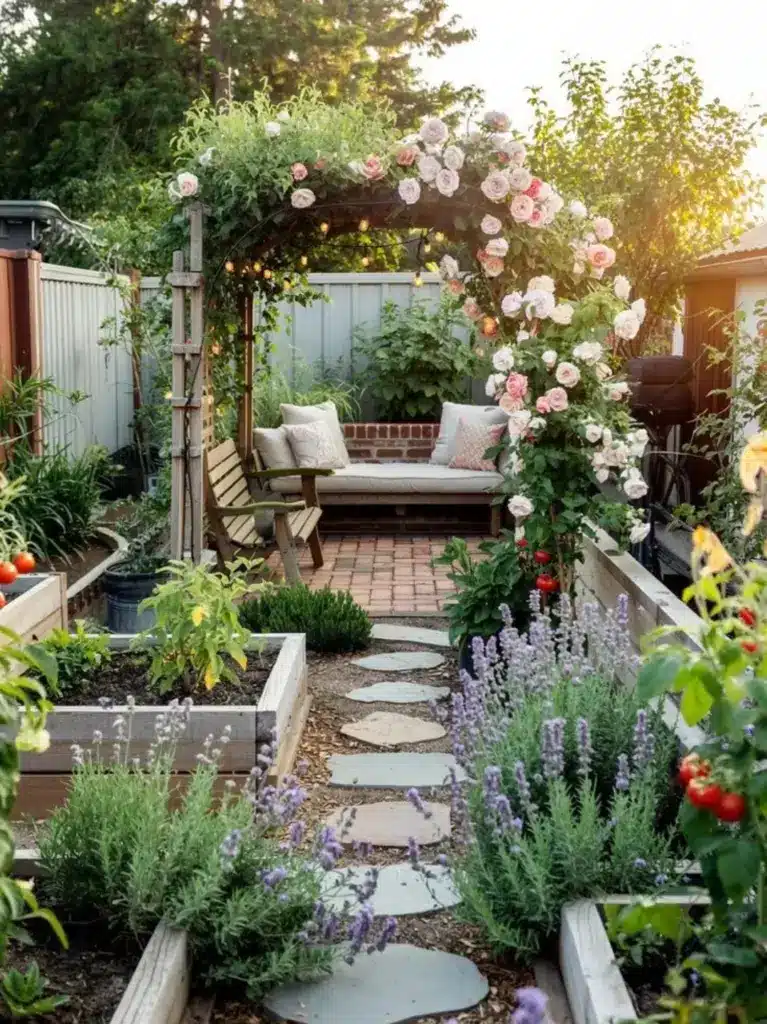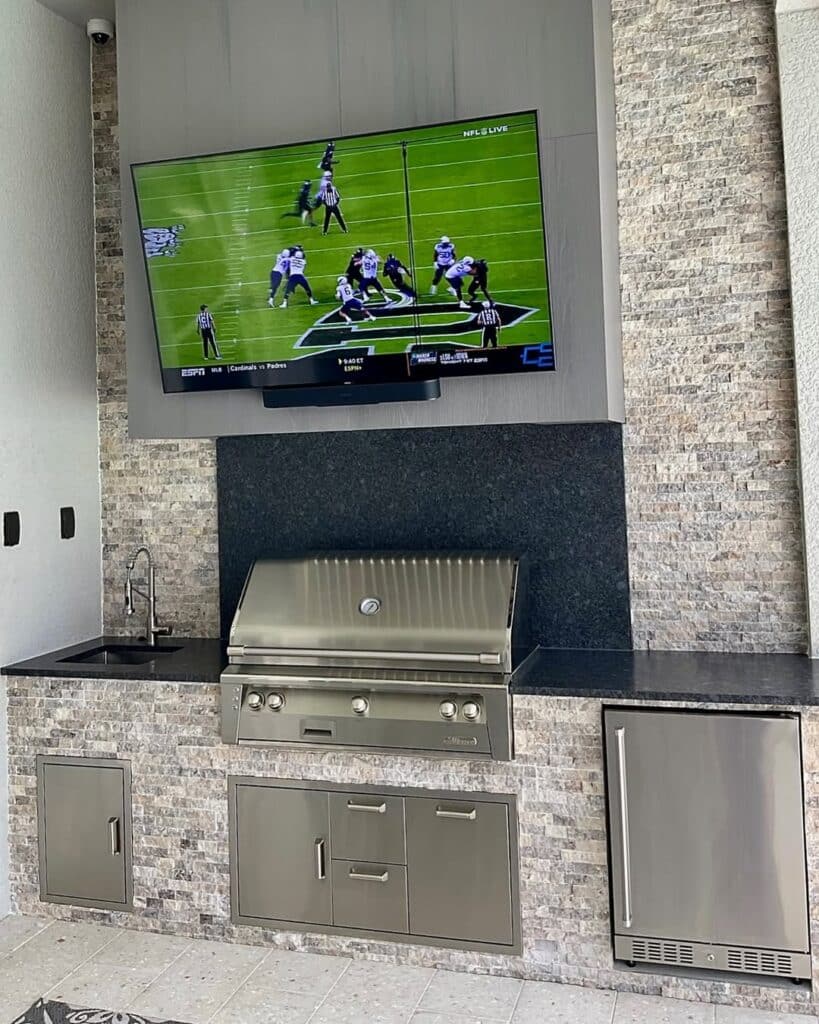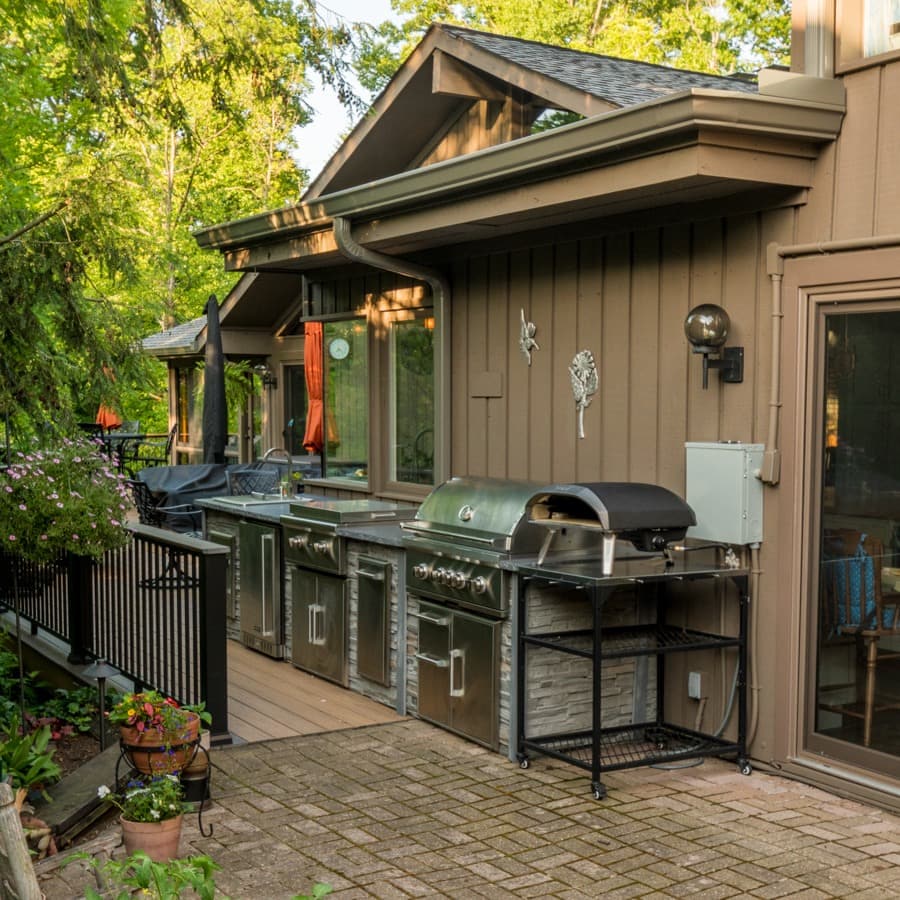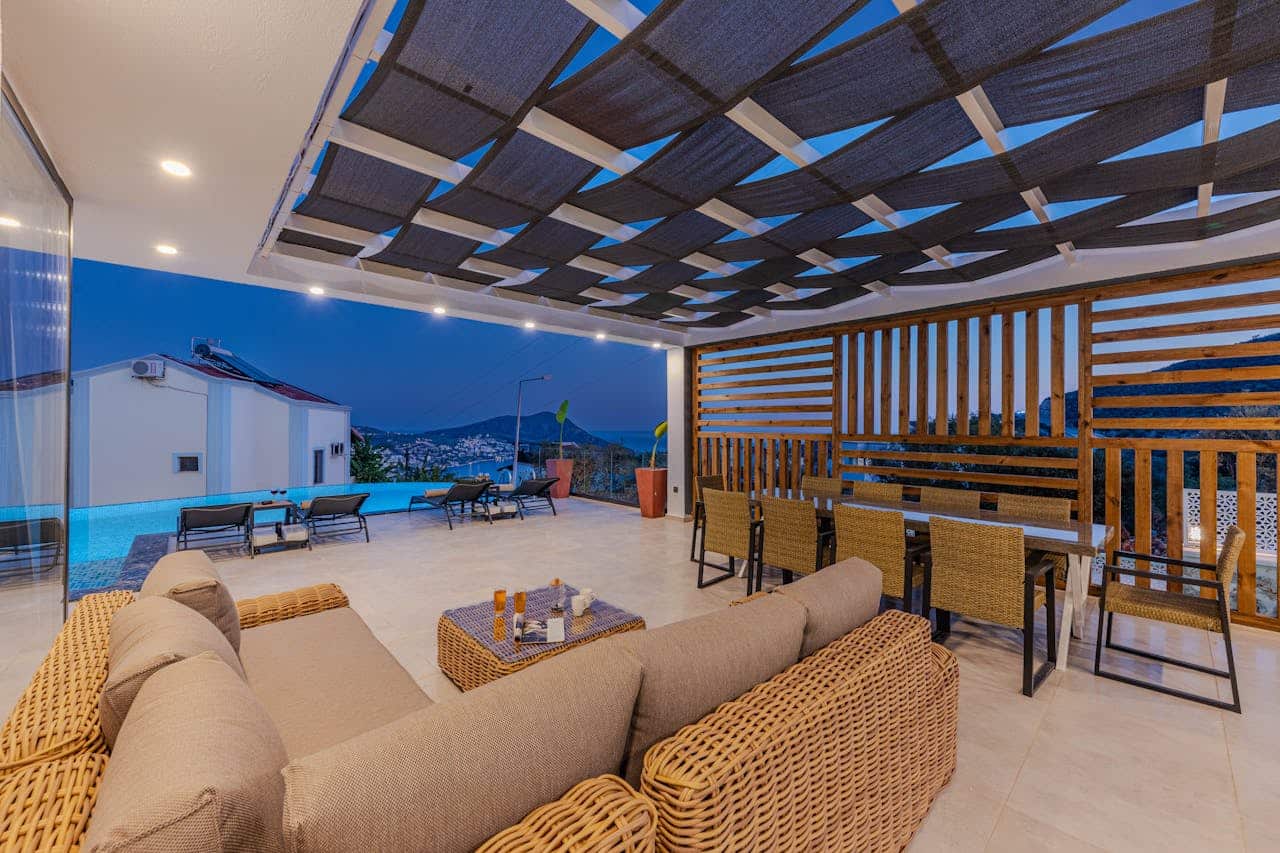Imagine cooking under the sun, flipping steaks while your guests lounge nearby with drinks in hand. That’s the magic of a well-designed outdoor kitchen. More than just a grill, it’s a functional, stylish extension of your home where entertaining, cooking, and relaxing converge.
Outdoor kitchens are not just a luxury – they’re an investment in lifestyle. Beyond aesthetics, they increase property value, expand your living space, and transform mundane backyard gatherings into memorable events.
In this guide, we’ll cover everything from design principles to appliances, budget tips, and maintenance, so you can create a backyard kitchen that’s both practical and impressive.
What is an Outdoor Kitchen?
At its core, an outdoor kitchen is a fully functional cooking area designed for outdoor living.
Think of it as your indoor kitchen’s cooler, breezier cousin. It’s more than a simple grill; it typically includes counters, prep areas, storage, sinks, and even refrigeration, all weatherproofed for outdoor use.
The outdoor kitchens benefits go far beyond convenience. Cooking outside reduces indoor heat, keeps the aroma outside (goodbye lingering garlic smell!), and encourages social interaction.
Families can cook, chat, and entertain simultaneously without anyone feeling trapped in the kitchen.
Outdoor kitchens can be as modest as a small patio setup with a grill and counter or as elaborate as a full backyard entertainment hub with bars, pizza ovens, and fire pits.
The key is flexibility – design it to match your space, lifestyle, and budget.

Essential Components of an Outdoor Kitchen
To understand outdoor kitchens benefits, you need to know what makes them work. Here’s a breakdown of the essentials:
1. Cooking Appliances
The grill is the heart of an outdoor kitchen. Gas grills offer precision and convenience, while charcoal grills provide smoky flavor. You can also include side burners for sauces, pizza ovens for wood-fired pies, or smokers for barbecue enthusiasts.
These appliances create flexibility and variety, making your outdoor kitchen more than a single-purpose setup.
2. Countertops & Prep Areas
A durable prep surface is crucial. Materials like granite, concrete, and stainless steel are weather-resistant and easy to clean. Good counter space ensures you can prep food efficiently while entertaining guests nearby. Think of it as your cooking stage – everything else revolves around it.
3. Storage Solutions
Storage might not be glamorous, but it’s essential. Weatherproof cabinets, drawers, and shelving keep utensils, spices, and tools accessible. Organization makes cooking outdoors less stressful – because there’s nothing worse than hunting for tongs while your guests are hungry.
4. Sinks & Plumbing
A functional sink simplifies washing, prepping, and cleaning. Even a small wet station elevates efficiency and hygiene. Proper plumbing adds convenience and ensures your outdoor kitchens benefits include less indoor mess.
5. Refrigeration & Beverage Centers
Outdoor-rated refrigerators, ice makers, and wine coolers are optional but highly desirable. Having chilled drinks and ingredients at arm’s reach transforms your outdoor kitchen from functional to entertainment-ready.
Design Considerations
Design isn’t just about looks; it’s about workflow, comfort, and safety.
1. Layout & Workflow
The “kitchen triangle” concept – cooking, prep, storage – applies outdoors too. Keep movement natural and unobstructed. A crowded space turns cooking into a workout, not a pleasure.
2. Seating & Entertainment
Consider bars, dining areas, and lounge zones. Lighting and fire pits extend usability into the evening. Outdoor kitchens are as much about socializing as cooking, so plan seating that encourages interaction.
3. Materials & Durability
Choose materials that withstand sun, rain, and humidity. Stainless steel, stone, and treated wood are popular because they balance durability with style. Nothing ruins a beautiful evening faster than warped cabinets or a rusted grill.
4. Aesthetic Integration
Your outdoor kitchen should complement your home and landscaping. Incorporate lighting, greenery, and textures that create a cohesive look. A modern steel counter might pair beautifully with stone pathways or wooden pergolas – balance is key.

Lighting and Ambience for Outdoor Kitchens
Proper lighting transforms an outdoor kitchen from functional to magical. Beyond just cooking, the right lighting sets the mood for entertaining. Consider:
- Task lighting: bright, focused lights over prep areas and grills for safety and efficiency
- Ambient lighting: string lights, lanterns, or recessed fixtures to create a warm, inviting atmosphere
- Accent lighting: highlight landscaping, counters, or architectural features
Tip: Use dimmers for adjustable mood lighting. Outdoor kitchens are not just about cooking – they’re social hubs. A well-lit space enhances outdoor kitchens benefits by extending usability into the evening.
Plus, proper lighting ensures no one ends up eating raw steak by accident.
Even simple solutions like solar-powered LED lights or motion-activated path lights improve safety while maintaining style. Think of lighting as the invisible element that makes your backyard kitchen shine day or night.
Flooring Options for Safety and Style
The right flooring ensures your outdoor kitchen is safe, durable, and stylish. Options include:
- Natural stone or pavers: elegant, slip-resistant, and long-lasting
- Concrete: versatile, durable, and easy to clean
- Tile: modern aesthetic, but check for outdoor slip-resistance
- Composite decking: blends with landscaping and provides warmth underfoot
Key Point: Flooring should handle water, grease, and temperature changes. Avoid surfaces that become slippery when wet.
Consider layering textures – like stone pathways with a concrete prep area – to define zones visually and functionally. Flooring plays a huge role in outdoor kitchens benefits, creating a space that’s safe, comfortable, and easy to maintain while complementing the overall design.
Weather Protection and All-Season Use
Outdoor kitchens are exposed to the elements, but with the right strategies, they can be used year-round:
- Pergolas, gazebos, or retractable awnings protect from sun and rain
- Outdoor heaters, fire pits, and infrared lamps extend cooking into colder months
- Protective covers for grills, appliances, and furniture prevent weather damage
Tip: Invest in high-quality covers and waterproof storage to maximize durability and minimize maintenance.
The goal is to enjoy your outdoor kitchen regardless of weather. All-season usability is a major outdoor kitchens benefit, ensuring your backyard remains a functional and inviting space for family and friends throughout the year.

Green and Sustainable Outdoor Kitchens
Sustainability is trending in outdoor kitchens, and it doesn’t have to be complicated. Consider:
- Eco-friendly materials: reclaimed wood, recycled stone, or bamboo counters
- Energy-efficient appliances: induction burners or solar-powered lights
- Rainwater capture: for cleaning or irrigation
- Native landscaping: reduces water use and maintenance
Key Point: A sustainable kitchen is both responsible and stylish. You can save energy, reduce waste, and still create a high-functioning entertainment space.
Incorporating eco-friendly elements enhances outdoor kitchens benefits, from lower utility costs to a smaller environmental footprint. It’s a way to cook, entertain, and relax responsibly, giving your backyard both charm and conscience.
Maximizing Storage and Organization
Storage is often overlooked but critical to outdoor kitchens benefits. Efficient storage keeps your space tidy and functional. Consider:
- Weatherproof cabinets and drawers: protect utensils and supplies from the elements
- Pull-out shelves and racks: maximize small spaces and improve accessibility
- Refrigerated storage: chilled drawers for meats, sauces, and beverages
- Hooks and overhead racks: keep tools handy without cluttering counters
Tip: Plan storage around workflow – place utensils near prep areas and grill tools within arm’s reach. Organized kitchens reduce stress, improve cooking efficiency, and enhance the overall experience for you and your guests.
A well-thought-out storage plan ensures your outdoor kitchen feels professional, comfortable, and inviting, making every meal a smooth, enjoyable process.
Popular Outdoor Kitchen Styles
When designing your backyard cooking space, choosing the right style sets the tone for both functionality and aesthetics. From rustic charm to sleek modern lines, popular outdoor kitchen styles help define your space and elevate your entertaining experience.
Mediterranean Style
Stone countertops, natural wood cabinets, warm colors, and terracotta accents. Evokes a rustic, sun-soaked villa vibe.
Modern/Minimalist Style
Sleek stainless steel, clean lines, monochrome palette. Perfect for a low-maintenance, futuristic backyard.
Rustic/Industrial Style
Brick, concrete, and reclaimed wood. Combines durability with a rugged, casual charm.
Tropical/Island Style
Bamboo, thatched roofing, bar-style seating. Brings a resort feel to your backyard entertaining.

Appliances & Tech Innovations
Modern outdoor kitchens are smart. IoT-enabled grills let you control temperature from your phone. Outdoor-rated fridges and wine coolers keep ingredients chilled. LED lighting, built-in speakers, and Wi-Fi integration make your backyard a high-tech entertainment hub.
Heating elements like infrared lamps or fire pits ensure you can cook year-round. These outdoor kitchens benefits enhance both comfort and functionality, letting your backyard become a true living space.
DIY vs Professional Installation
DIY outdoor kitchens save money but require planning, skill, and patience. Professionals bring expertise in layout optimization, plumbing, electrical work, and building codes.
Consider hiring a contractor if you want complex features like gas lines, built-in refrigeration, or stone countertops.
Pro tip: even if you DIY, consult a professional for critical installations to avoid costly mistakes or safety issues.
Cost Breakdown & Budgeting
Outdoor kitchens range from $2,000 for a basic setup to $50,000+ for high-end designs. Budget for:
- Appliances (grills, ovens, fridges)
- Countertops and cabinets
- Sinks, plumbing, and lighting
- Seating and décor
Plan realistically. Overloading with unnecessary gadgets can blow your budget and make maintenance a nightmare. Smart choices maximize outdoor kitchens benefits without overspending.
Maintenance & Seasonal Care
Proper care is key to keeping your outdoor kitchen looking great and functioning smoothly year-round. Maintenance and seasonal care ensure durability, protect your investment, and make every cooking experience stress-free.
- Clean appliances and surfaces regularly
- Cover or store items during harsh weather
- Winterize sinks, plumbing, and grills if necessary
- Protect wood and stone with sealants
Proper maintenance extends your kitchen’s lifespan and keeps it looking and functioning like new, which is a huge part of the outdoor kitchens benefits.

Entertaining Tips & Outdoor Kitchen Etiquette
An outdoor kitchen is as much about socializing as it is about cooking, so knowing a few entertaining tips can elevate the experience for everyone. Outdoor kitchen etiquette ensures your guests feel comfortable while keeping your space organized and enjoyable.
- Set up food and drinks for easy access
- Encourage casual, hands-on dining
- Use outdoor-friendly dishes and utensils
- Provide wet wipes or napkins – trust me, you’ll thank me after chili and sauce-heavy nights
The goal is fun, not perfection. Your outdoor kitchen is a stage for memories, not a photo shoot.
Common Mistakes to Avoid
Even the best outdoor kitchen can fall short without careful planning. Knowing the common mistakes to avoid helps you maximize both functionality and the outdoor kitchens benefits of your backyard setup.
- Poor layout and obstructed workflow
- Choosing materials that can’t withstand weather
- Ignoring lighting and seating needs
- Overspending on gadgets that rarely get used
- Skimping on storage or prep space
Avoiding these ensures you maximize outdoor kitchens benefits for both cooking and entertainment.
Future Trends in Outdoor Kitchens
Outdoor kitchens continue to evolve with technology, design, and lifestyle trends. Exploring the future trends in outdoor kitchens can inspire innovative features that boost functionality, sustainability, and entertainment value.
- Smart appliances and IoT integration
- Sustainable, eco-friendly materials
- Multi-season outdoor living spaces with heaters and retractable coverings
- Outdoor kitchens as extensions of indoor living areas
Stay ahead of trends, but always prioritize functionality and durability.

FAQ: Outdoor Kitchens Explained
1. What is an outdoor kitchen?
An outdoor kitchen is a fully functional cooking area designed for outdoor living. It usually includes a grill, counters, storage, sinks, and refrigeration, all built to withstand weather. Unlike a simple barbecue, it’s a complete space for cooking, entertaining, and relaxing outdoors.
2. What are the main benefits of an outdoor kitchen?
The outdoor kitchens benefits include:
- Reduced indoor heat while cooking
- Enhanced social interaction during meal prep
- Increased property value
- Expanded living and entertaining space
- A stylish, functional addition to your backyard
3. What essential components does an outdoor kitchen need?
Key elements include:
- Cooking appliances (grill, pizza oven, smoker)
- Countertops and prep areas
- Storage solutions (cabinets, drawers)
- Sinks and plumbing
- Refrigeration and beverage centers
4. How do I choose the right materials for my outdoor kitchen?
Opt for durable, weather-resistant materials such as stainless steel, granite, concrete, treated wood, and stone. Materials should handle sun, rain, and temperature changes while maintaining style and functionality.
5. Should I DIY or hire a professional to build my outdoor kitchen?
DIY is great for small setups, but professionals are recommended for complex features like gas lines, stone counters, or full plumbing. Consulting a pro ensures safety, efficiency, and longevity.
6. What flooring options work best for outdoor kitchens?
Safe, durable, and stylish options include:
- Natural stone or pavers
- Concrete
- Slip-resistant tile
- Composite decking
Flooring should resist water, grease, and temperature changes while defining cooking and entertaining zones.
7. How can I use my outdoor kitchen year-round?
Add weather protection such as pergolas, retractable awnings, or gazebos. Outdoor heaters, fire pits, and infrared lamps allow cooking and entertaining in colder months. Protective covers keep appliances in good condition.
8. How can I make my outdoor kitchen eco-friendly?
Use reclaimed or sustainable materials, energy-efficient appliances, rainwater capture systems, and native landscaping. This reduces your environmental impact while enhancing durability and style.
9. What are common mistakes to avoid in outdoor kitchen design?
Avoid:
- Poor layout or obstructed workflow
- Low-quality, non-weatherproof materials
- Ignoring lighting or seating needs
- Overbuying gadgets
- Insufficient storage or prep space
These mistakes reduce functionality and limit outdoor kitchens benefits.
10. How do I maintain an outdoor kitchen?
- Clean surfaces and appliances regularly
- Cover or store items during harsh weather
- Winterize plumbing and grills if needed
- Seal wood or stone surfaces to protect against elements
Regular maintenance extends lifespan and keeps your kitchen functional and beautiful year-round.
Final Thoughts
An outdoor kitchen is more than a trend – it’s an investment in lifestyle, property value, and social experiences.
From functional grills and sinks to stylish seating and high-tech appliances, a well-designed outdoor kitchen transforms your backyard into a living, entertaining, and cooking space.
Whether you DIY or hire a professional, understanding outdoor kitchens benefits – from workflow and durability to entertainment potential – ensures your backyard becomes the ultimate place to cook, relax, and connect.
Start planning today and turn your backyard into a chef-approved, guest-loved paradise.
Featured image credit: Credit: Ahmet ÇÖTÜR

